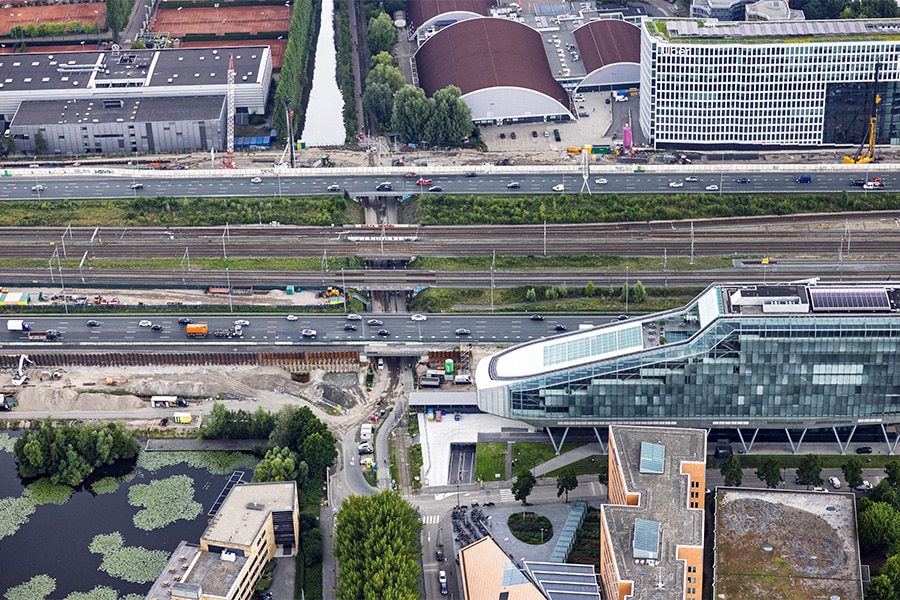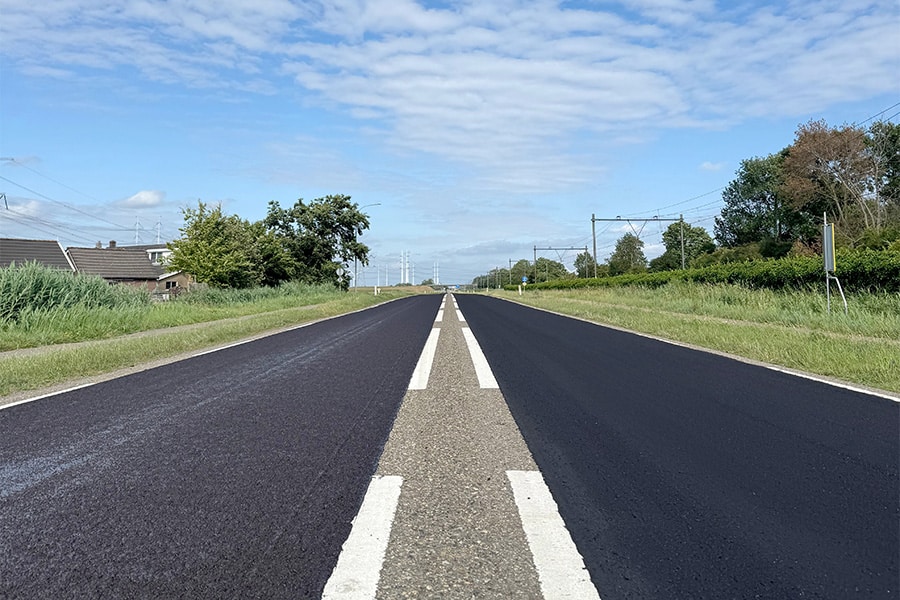
A16 Rotterdam project gets first energy-neutral highway including 2.2 km long tunnel
Consortium The Green Bow guarantees 20 years of energy neutrality
The A16 Rotterdam project is buzzing with activity. Commissioned by Rijkswaterstaat, consortium De Groene Boog, which includes the companies BESIX, Dura Vermeer, Van Oord, TBI (Mobilis, Croonwolter&dros), Rebel and John Laing, is realizing the new A16 Rotterdam, an 11-kilometer-long national highway between the A16/A20 at Terbregseplein and the A13 at Rotterdam The Hague Airport. This project is characterized by a high level of innovation in all areas, especially when it comes to sustainability. The route includes a 2.2 km long tunnel, which, like the road itself, will be energy-neutral. We talk to Stefan van der Voorn, contract manager at Rijkswaterstaat and Hans Pos (Croonwolter&dros), designer and test manager at De Groene Boog.
Highly energy-efficient design
Van der Voorn opens the conversation, "The energy consumption of the highway, including the Rottemer Tunnel, was an EMVI tender. Rijkswaterstaat went for a reduction of 50% in energy consumption, compared to a standard tunnel and road. De Groene Boog came up with a design that will be energy-neutral for the next 20 years." Pos: "In the tender phase, we looked at what would be really good solutions. If you look at most of the installations in the Rottemer Tunnel, you see that they are powered with DC (direct current), instead of AC (alternating current). Out of that came the innovative plan to work with a DC network. In order not to waste energy, we mapped how much consumption you have in the tunnel, we made the power balance."
"The energy for the highway and tunnel will be generated with solar panels," Van der Voorn continued. "The tunnel design is so energy-efficient that it can be done. By working with a DC network, with extra light walls, asphalt with a reflective coating and by using LED lighting and switching it in such a way that less energy is needed, energy use is drastically reduced. Right now, tests are being done to see how best to set up the LED lighting, what image it will create for road users and whether everything meets safety standards." Pos explains: "By adding up all the savings, we were able to determine how many kW we needed, coupled with an investigation into whether solar panels could provide this power. That turned out to be the case. We included in this study the energy consumption of both the road and the tunnel, that is, the entire route."

Demonstration phase
At the time of this interview, tests are being conducted in several tunnels, including the Gaasperdamer Tunnel and the Rijnland Tunnel. Pos: "We are in the demonstration phase. Also at the COB (center for underground construction) we looked at lighting. There, 13 tickets were created with possibilities, 9 of which we were able to apply to the A16 Rotterdam. Colleague Dennis Makkus of Croonwolter&dros handled these tickets and became project leader of this study. For each ticket a special working group was set up, in each of these groups someone from Rijkswaterstaat, De Groene Boog and from an external expert party participates."
The difference between LED and traditional lighting
Looking at the 11 km stretch, the road involves lighting and roadside systems; in the tunnel (2.2 km), we find 54 systems that need to be fed. "That makes the primary focus on the tunnel," Van der Voorn says. "But, really anything with energy consumption is included. The fans in the tunnel do run on alternating current; the rest can be powered with direct current. There's a huge gain there."
However, switching from traditional lighting to LED is no easy task, it has turned out. Pos explains: "LED is perceived differently by the human eye. The light beam is not diffuse, but directed. That makes led lighting quickly perceived as blinding. We are therefore investigating how far we must 'scale back' the light intensity in order to meet the requirements for tunnel lighting without burdening the human eye. In the Gaasperdamer Tunnel and the Kethel Tunnel, among others, live tests have been conducted for this purpose, with drivers within different age groups. With that data, we are looking at whether it is possible to write an addendum that can be added to the NSVV (Dutch Foundation for Lighting Science), or with which the NSVV can make adjustments. We are also looking at the L20 cameras, which record how much the tunnel mouth should be illuminated. In addition, for the light-dark transition of the tunnel mouths, we are looking at a transition with louvers that allow daylight to pass through, which does not cost any energy at all. With the tickets from the CDE, we are looking at where the lighting can be improved and made more energy efficient."
One more big wish...
The concept of the tunnel fits completely within the National Tunnel Standard. "In that it is mainly about availability and safety. We have added sustainability to that," says Van der Voorn. "There will soon be a nice blueprint for new tunnel projects to work with. An important learning point in this whole process is that you have to pay full attention in the planning phase to the question of where the power is going to come from, how are you going to generate it. Then that location could have been included in the route decision."
One big wish remains in the whole plan: energy storage. "The solar panels will soon give the energy back to the grid, while we would very much like to make direct use of the generated energy. Because to do that, the energy has to be stored, at relevant locations near the road and the tunnel. You have to find suitable places for that of about 10 m2. The idea won't let us go and we latched on to it. Who knows if we manage to pull it off, that would be the icing on the cake," Van der Voorn concluded.




